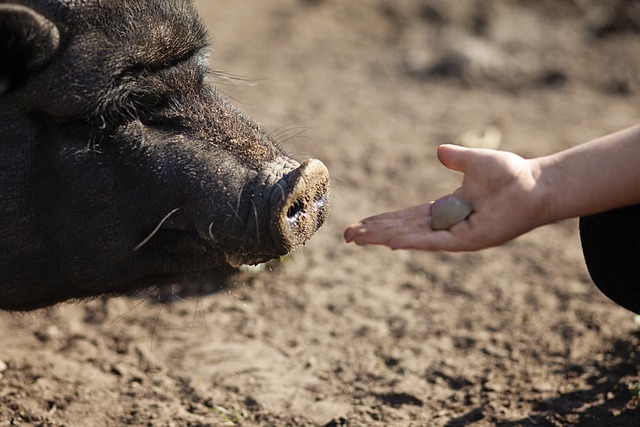The nutritional aspects of pig management involve a consideration of the digestive system of the pig.
More so, the factors affecting digestion, feed composition, pretreatment of feeds, and nutritional requirements during the different stages or phases of life.
The formulation and balancing of nutrients in pig rations and feeding management are very essential for efficient pork production.
Pig’s Digestive System
In many ways, the physiology of digestion and absorption in the pig is similar to that of man.
Like man, the pig is omnivorous, consuming food of both plant and animal origin.
The alimentary tract or canal of the pig extends from the lips to the anus.
Major parts of the alimentary canal are the mouth, pharynx, esophagus, stomach, small intestine, and large intestine.
Its function is to provide the necessary environment for the digestion and absorption of food.
Digestion involves the following.
- Breaking down complex foodstuffs into simpler compounds
- Absorption of nutrients through the wall of the intestine into the bloodstream or lymphatic system
- Transfer of nutrients to the parts of the body where they are needed.
Enzymes are chemicals that aid the process of digestion.
Each enzyme is found in a particular part of the alimentary canal and aids in the breakdown of a specific compound.
Mouth
Under natural conditions, the pig roots, i.e. it digs up the soil, with its snout, and carries the food to its mouth using the pointed lower lip.
When pigs are not permitted to root, the food is picked up using the teeth, tongue, and characteristic movement of the head.
In the mouth, the food is ground into a pulp by the teeth and mixed with saliva.
The enzyme ptyalin, in saliva, begins to break down the food.
The food is then pushed to the back of the mouth or pharynx and passes down e esophagus into the stomach.
Stomach
In the stomach, the food is churned up by the squeezing action of the muscular walls, and gastric juice is added to it.
The gastric juice is produced by the gastric glands in the walls of the stomach and contains mucus, hydrochloric acid, and pepsin.
The mucus lubricates the food. The hydrochloric acid provides an acid environment that prevents the further action of the ptyalin from the saliva and provides a suitable environment for the action of pepsin.
The pig has a simple stomach that can only digest concentrate feeds such as grains and their by-products, nuts, legumes, and other seeds and their by-products, and fish and mammalian by-products.
Small intestine
In the small intestine, secretions, or juices from the pancreas, liver, and small intestine complete the process of digestion.
The digested food can then diffuse through the walls of the small intestine.
Pancreatic juice contains enzymes for digesting the three major types of food: protein, carbohydrates, and fats.
The proteolytic enzymes trypsin and chymotrypsin partially digest proteins.
The enzyme pancreatic amylase hydrolyzes starch to maltose.
The fats are broken down into carboxylic acids and glycerol by the action of lipase.
Bile is created continually by the liver. The bile contains no digestive enzyme but is important in digestion because of the presence of the bile salts, which emulsify fat globules so that they are more easily digested by lipase.
Intestinal juices contain the following enzymes:
1. Several peptidases for splitting polypeptides into amino acids
2. Enzymes for splitting the disaccharides, sucrose, maltose, isomaltose, and lactose into monosaccharides such as glucose, fructose, and galactose:
3. Intestinal lipase for splitting neutral fate into glycerol and carboxylic acids; and
4. Very small amounts of intestinal amylase for splitting carbohydrates into disaccharides.
Large intestine
The large intestine is the site for the absorption of water into the body.
It secrets mucus to lubricate the undigested food. In response to bacterial infection, it secrets large volumes of water and electrolytes.
This action dilutes the irritating factors and causes rapid movement of the feces toward the anus, resulting in diarrhea.
Absorption
Food absorption does not take place in the mouth and esophagus.
The small intestine is the major site of food absorption.
The mucous membrane of the small intestine is highly modified as an organ of absorption by the presence of a large number of tiny finger-like projections called villi.
These villi increase the surface area of the intestinal wall and so provide a large surface area for the absorption of food.
In pigs, the villi are shorter in length than in other farm animals.
The absorbed foodstuffs may be transported around the body by the lymph and by the blood portal system.
Fats are absorbed primarily but the lymph. Carbohydrates and products of protein digestion, water, and inorganic salts are absorbed primarily by the blood.








